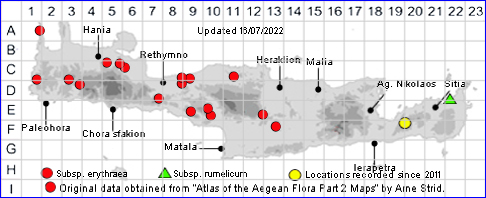
SPECIES DESCRIPTION
CENTAURIUM ERYTHRAEA subsp. ERYTHRAEA
Including:- Subsp. rumelicum resembling Subsp. erythraea, but differing in the
following characteristics, small, slender plant, middle cauline leaves linear-oblong,
acute. Inflorescence lax. Corolla lobes 3-5 mm
Family and Genus:- See- GENTIANACEAE/Sect. CENTAURIUM
Common Name:- Common centaury
Homotypic Synonyms:- None
Meaning:- Centaurium (L) For the centaur, Chiron, who was said to have a wide
knowledge of herbs.
Erythraea (Gr) Reddish.
Rumelicum (L) From Roumelia, SE Europe.
General description:- Variable short to medium biennial.
Stem:-
1) (3-)10-50 cm, generally solitary, sometimes several, usually branched in the
upper part.
Leaves:-
1) Basal, obovate to elliptic, 1-5 cm long, with a blunt tip 3-7 veined.
3) Middle cauline, usually narrowly lance-shaped or narrowly elliptical.
4) Lower, in a distinct, persistent rosette.
5) Upper cauline, much smaller 3-veined and pointed.
Flowers:-
1) Pink to purplish, rarely white.
2) Flowers, in a corymbiform, capitate or dichasial cyme, rarely solitary.
3) Corolla-lobes, usually 5-6 mm.
4) Calyx, usually c. ½ as long as the corolla-tube.
5) Stamens, inserted at the apex or at the base.
Fruit:-
1) A septicidal capsule, valves remain attached.
Key features:-
1) Corolla-lobes usually 5-6 mm.
2) Middle cauline leaves, lanceolate, narrowly lanceolate or narrowly elliptical.
3) Inflorescence dense.
4) Stem, margin of leaves, bracts and calyx smooth.
5) Cauline leaves, usually lanceolate or wider, rarely linear-spathulate, never
parallel-
sided, usually 3- veined.
6) Rosette leaves, more than 5 mm wide, 3- to 7-veined oblong-obovate or obovate,
sided, usually 3- veined.
7) Calyx, usually 1/2 as long as the corolla-tube.
Habitat:- Coastal habitats, scrubland vegetation, damp pastures, open meadows
and woodland. 0-1100 m.
Distribution:- Widespread around the Mediterranean but not common. Scattered
mainly across central and western Crete. With one location discovered on Afendis
Kavousi in 2011
Flowering time:- Late Apr to early Aug.
Photo by:- Steve Lenton
